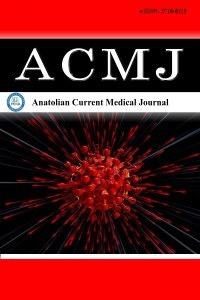Predialysis education program and early vascular access: a single center experience
Predialysis education program and early vascular access: a single center experience
End-stage kidney disease, Pre-dialysis education, Maintenance hemodialysis Morbidity, Vascular access.,
___
- Hill NR, Fatoba ST, Oke JL, Hirst JA, et al. Global prevalence of chronic kidney disease - a systematic review and meta-analysis. PLoS One. 2016;11(7):e0158765.
- Glassock RJ, Warnock DG, Delanaye P. The global burden of chronic kidney disease: estimates, variability and pitfalls. Nat Rev Nephrol. 2017;13(2):104-114.
- Fluck R, Kumwenda M. Renal Association Clinical Practice Guideline on vascular access for haemodialysis. Nephron Clin Pract. 2011;118 Suppl 1:c225-c240.
- Hoggard J, Saad T, Schon D, et al. Guidelines for venous access in patients with chronic kidney disease. A Position Statement from the American Society of Diagnostic and Interventional Nephrology, Clinical Practice Committee and the Association for Vascular Access. Semin Dial. 2008;21(2):186-191.
- Levin A, Lewis M, Mortiboy P, et al. Multidisciplinary predialysis programs: quantification and limitations of their impact on patient outcomes in two Canadian settings. Am J Kidney Dis. 1997;29(4):533-540.
- Chanouzas D, Ng KP, Fallouh B, Baharani J. What influences patient choice of treatment modality at the pre-dialysis stage? Nephrol Dial Transplant. 2012;27(4):1542-1547.
- Van den Bosch J, Warren DS, Rutherford PA. Review of predialysis education programs: a need for standardization. Patient Prefer Adherence. 2015;9:1279-1291.
- Lin MY, Cheng LJ, Chiu YW, et al. Effect of national pre-ESRD care program on expenditures and mortality in incident dialysis patients: a population-based study. PLoS One. 2018;13(6):e0198387.
- Campbell-Montalvo R, Jia H, Shukla AM. Supporting shared decision-making and home dialysis in end-stage kidney disease. Int J Nephrol Renovasc Dis. 2022;15:229-237.
- Kalantar-Zadeh K, Lockwood MB, Rhee CM, et al. Patient-centred approaches for the management of unpleasant symptoms in kidney disease. Nat Rev Nephrol. 2022;18(3):185-198.
- Murea M, Grey CR, Lok CE. Shared decision-making in hemodialysis vascular access practice. Kidney Int. 2021;100(4): 799-808.
- Combes G, Sein K, Allen K. How does pre-dialysis education need to change? findings from a qualitative study with staff and patients. BMC Nephrol. 2017;18(1):334.
- Jia T, Bi SH, Lindholm B, Wang T. Effect of multi-dimensional education on disease progression in pre-dialysis patients in China. Ren Fail. 2012;34(1):47-52.
- Singhal R, Hux JE, Alibhai SMH, Oliver MJ. Inadequate predialysis care and mortality after initiation of renal replacement therapy. Kidney Int. 2014;86(2):399-406.
- Craig JC, Molony DA, Strippoli GFM. Evidence-Based Nephrology, 2 Volume Set. John Wiley & Sons; 2022.
- Dsouza B, Prabhu R, Unnikrishnan B, et al. Effect of educational intervention on knowledge and level of adherence among hemodialysis patients: a randomized controlled trial. Glob Health Epidemiol Genom. 2023;2023:4295613.
- Saran R, Bragg-Gresham JL, Rayner HC, et al. Nonadherence in hemodialysis: associations with mortality, hospitalization, and practice patterns in the DOPPS. Kidney Int. 2003;64(1):254-262.
- Parvan K, Hasankhani H, Seyyedrasooli A, Riahi SM, Ghorbani M. The effect of two educational methods on knowledge and adherence to treatment in hemodialysis patients: clinical trial. J Caring Sci. 2015;4(1):83-93.
- Tarverdizade Asl P, Lakdizaji S, Ghahramanian A, Seyedrasooli A, Ghavipanjeh Rezaiy S. Effectiveness of text messaging and face to face training on improving knowledge and quality of life of patients undergoing hemodialysis: a randomized clinical trial. J Caring Sci. 2018;7(2):95-100.
- Shimizu Y, Nakata J, Yanagisawa N, et al. Emergent initiation of dialysis is related to an increase in both mortality and medical costs. Sci Rep. 2020;10(1):19638.
- Yayın Aralığı: 6
- Başlangıç: 2019
- Yayıncı: MediHealth Academy Yayıncılık
Gökhan ÖZGÜR, Esmeray MUTLU YILMAZ
Predialysis education program and early vascular access: a single center experience
Mahmud İSLAM, Kenan Evren ÖZTOP
Evaluation of immunochromatography method in the diagnosis of cystic echinococcosis
Özlem KOCA, Özgül ÇETİNKAYA, Aylin ERMAN DALOĞLU, Yeşim ÇEKİN, Hatice ÖZEN
Halil ER, Özlem KOCA, Nevgün Sepin ÖZEN
Farklı çay markalarının akışkan rezin kompozitin renk değişimine etkisi
Merve YENİÇERİ ÖZATA, Elif Pınar BAKIR, Samican ÜNAL, Gamze POLAT, Ebru AKLEYİN
The prevalence of anomalies in the lumbar spine in the Turkish male population
Burhan KURTULUŞ, Osman Yağız ATLI, Evrim DUMAN
Betül CENGİZ ELÇİOĞLU, Yasemin DEMİRCİ, Mert Pehlivan ALTIN, Erol GÜRSOY, Vedat AYTEKIN, Saide AYTEKIN
